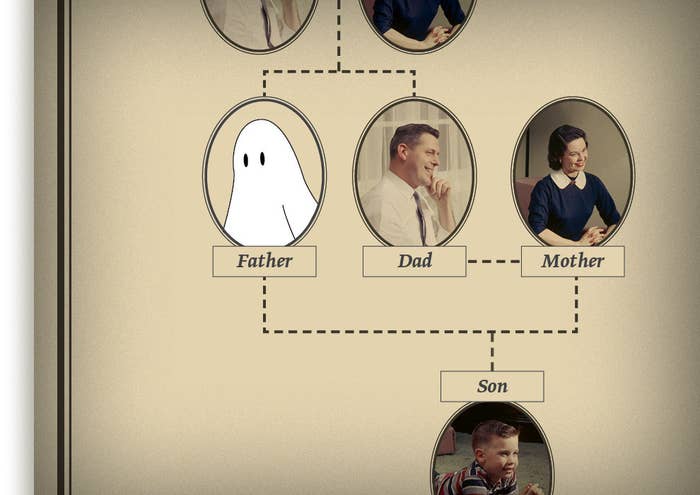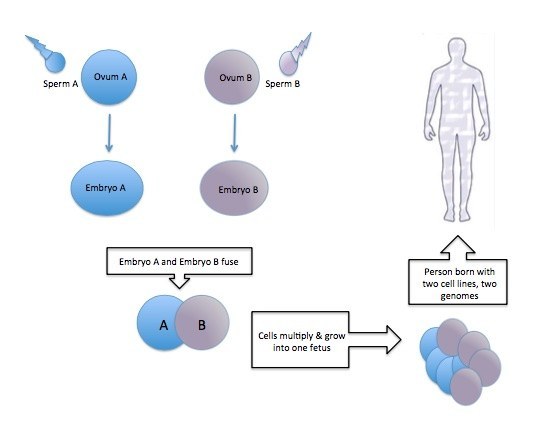
How can a man who was never born father a son? When the ghost of his genes lives on in the DNA of his brother, genetics researchers have found.
A 34-year-old U.S. man is the first-ever reported case of a paternity test fooled by a human “chimera” — someone with extra genes absorbed from a nascent twin lost in early pregnancy.
About 1 in 8 single childbirths are thought to have started as multiple pregnancies. Cells from these miscarried siblings are sometimes absorbed in the womb by a surviving twin — but are only rarely discovered by surprises such as the paternity-test puzzle.
“Even geneticists are blown away by this,” Barry Starr, a geneticist at Stanford University, told BuzzFeed News.
Last year, a Washington couple came to Starr, who answers the “Ask a Geneticist” questions on the website of the Tech Museum of Innovation in San Jose, California, looking for help with what appeared to be a mistake at a fertility clinic. The answer to their mystery points to a possible genetic loophole in standard paternity testing, Starr said — “one where we have no idea how big the problem is.”
In June 2014, the parents (who have chosen to remain unnamed because of concerns for their privacy and confidentiality of medical records) had a son with the help of fertility clinic procedures. The boy was born healthy, but strangely, his blood type didn’t match that of his parents.
An at-home paternity test suggested an explanation: The man wasn’t actually the father of the child.
“You can imagine the parents were pretty upset,” said Starr, whose colleagues have presented the case at two scientific meetings this month, most recently the International Symposium on Human Identification meeting. “They thought the clinic had used the wrong sperm.”
The parents hired a lawyer and sought a more precise paternity test from an accredited lab. Just like the at-home test, the new analysis relied on skin cells from a cheek swab to check the father’s genes against the child’s. Again, the test came back negative for paternity.
Accredited U.S. labs perform nearly 400,000 paternity tests every year in legal, immigration, and criminal cases, with more than 99% of them relying on cheek swab samples. About 24% find that the man is not the father of the child.
Concerned that the fertility clinic had made a mistake, the Washington couple approached them with the results of the paternity test. But the fertility clinic said that the 34-year-old father was the only white man to donate sperm at the facility on the day their son was conceived, and the child looked white.
That was when the couple approached Starr, who suggested they test the father and son with a direct-to-consumer genetic ancestry test sold by the startup firm 23andMe. The results of those tests came back late last year. Bizarrely, their results said that the man was his son’s uncle.
“That was kind of a eureka moment,” said Starr. At that point, he realized they might be dealing with a chimera.
“Chimera reports are very rare, but they are real.”

People usually have just one set of genes — half of them from their mother and half from their father.
But in 2002, researchers reported the chimeric case of Karen Keegan in the New England Journal of Medicine, a rare case of maternity testing being fooled by a ghost’s genes.
Keegan needed a kidney transplant, and her sons, as close relatives, were tested as possible donors. The gene tests, however, said the 52-year-old Boston woman wasn’t actually the mother of her children.
She was a chimera. Tests revealed that while her blood cells had one set of genes, her ovaries held distinctly different ones. Those ovaries had produced the eggs that led to two of Keegan’s sons holding genes different from her own, said Lynne Uhl, a pathologist at Beth Israel Deaconess Medical Center and co-author of the NEJM study. The researchers reported that these different genes most likely came from a lost twin of Keegan’s, one whose cells she had absorbed while she was an embryo in her own mother’s womb.
The true genetic mother was a twin sister who she never knew and who was never born — a ghost.
A similar case in 2006 saw a 26-year-old chimeric woman, Lydia Fairchild, almost lose her children after maternity tests required for welfare payments suggested she wasn't actually their mother.
In the case of the Washington couple, the suspicion of male chimerism suddenly looked likely after the ancestry test indicated that he was his son’s uncle. Unlike standard paternity tests, which look for only about 15 genetic markers and test just for fatherhood, 23andMe and other genetic heritage firm tests looks at hundreds of thousands of markers in a bid to establish genetic genealogies for entire families.
One clue was that the Washington father did have curious two-toned striped skin, discovery team member Michael Baird of DNA Diagnostics Center in Fairfield, Ohio, told BuzzFeed News. The light and dark strips were so pronounced that as a child the man had escaped teasing by telling other children that he was a burn victim. “That certainly is suggestive of chimerism,” Baird said.
Starr reached out to genetic counselor Kayla Sheets of Vibrant Gene Consulting in Cambridge, Massachusetts, earlier this year to confirm the chimerism suspicion, and she in turn recruited Baird’s lab. Cheek swab genetic tests again ruled out the man as the father of his son.
But a test of the man’s semen found out that about 10% of its cells were genetic matches to the infant boy, Baird said. “The sperm showed (the father) was indeed a genetic chimera.”
The father of the boy is effectively the man’s own vanished twin — another ghost —the researchers concluded.
“Human chimerism is very common, but exquisitely difficult to identify, coming to light almost exclusively by accidents like this,” biologist Charles Boklage of East Carolina University told BuzzFeed News by email.

Crime and medical dramas such as CSI, Grey’s Anatomy, and House: MD have played with chimerism as a plot device for more than a decade.
But in reality, searches for chimeras are complicated because the genes pop up in detectable amounts only in some organs. The father in the Washington case, for example, had cheek cells that displayed only one set of genes, which means that his chimerism would never have been revealed by standard tests. Currently, about 99% of accredited labs rely on the older test that searches for fewer markers and doesn’t check for sibling DNA.
Although eyes of mismatched color and intersex conditions can be telltale signs of chimerism, most often there aren’t any obvious giveaways. And geneticists aren’t going to start plumbing the organs of healthy people to test for ghost genes that don’t have any noticeable effects, Starr said.
Starr suggests that paternity tests should search for more markers, similar to the 23andMe analysis, to detect chimerism. Only about 100 cases of human chimerism have been reported in the medical literature, but one study suggested it may affect about 8% of multiple births.
Uhl, an author on the 2002 female chimerism report, though, was cautious about anyone relying on direct-to-consumer ancestry kits as tests for chimerism. In 2013, the FDA halted 23andMe from offering health-related gene results to customers, calling it inappropriate medical advice. The agency allowed the firm to resume reporting a smaller number of such health results just this week.
Nevertheless, Starr suggested that chimerism may affect many more paternity tests than just the Washington case. As more people turn to fertility clinics to help them have children, he added, chimerism might become even more common, because fertility treatments lead to multiple births much more often than conventional pregnancies.
“Chimerism wasn’t even really something we thought a lot about until DNA testing came of age,” Starr said. “We are going to find more.”
